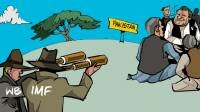Budget 2013-14 that the PML-N government is expected to unveil in the second week of June will be more of a bureaucratic exercise of number crunching with dimmed hopes of any break from past practices, with little room for maneuverability due to time constraints and inability to tide over fiscal difficulties in the short-run.
Much of the work on the new budget has already been done by the bureaucrats in the Ministry of Finance and the Federal Board of Revenue along with the PML-N leadership, yet to take the reigns of the government from the caretaker setup.
Under the circumstances, the new government cannot even think of touching 95 per cent of the expenditures.
Whatever the austerity measures, if announced by the PML-N government, will be symbolic in nature without any meaningful impact on the overall tight fiscal position of the country. The desire of the PML-N Chief Mian Nawaz Sharif to cut non-development expenditures by 30 per cent will be constricted only to expenditures proposed for running the civilian government. The proposed amount under this head for the next year is merely Rs278 billion, half of which goes for paying salaries.
The slogan of economic revival that the PML-N raised during the general elections that swept it to power would not immediately start delivering on the economic front, a fact that PML-N’s senior leader Sartaj Aziz admitted while speaking to Reuters.
To a question on seeking a new bailout programme from the IMF, Aziz said, “If our economic revival package starts working in two months, three months’ time, and it is clear that exports are picking up, our revenues are going up, then you need much less adjustment than indicated by the present situation.”
People who have high expectations of relief from the five years of hardships that the PPP government brought upon them due to its sheer economic mismanagement, there might not be much good news for them in this budget.
Two factors indicate continuation of the status quo on the economic front, for at least one more year. The encirclement of the PML-N leadership by the banking and financial sector mafia’s people, and the PML-N nominee for the finance minister’s slot Senator Ishaq Dar’s presentation of a blueprint of the new budget to the PML-N leadership that has been prepared by the dwellers of the ‘Q’ block, the seat of the finance ministry.
“The world is watching Pakistan very closely and any indication of status quo will result in the withdrawal of possible support of the international community that is necessary for the economic revival”, warned Dr Ashfaque Hasan Khan, Dean Business School of National University of Science and Technology, Islamabad.
Forming a new government, just weeks before the next year’s budget, is also constraining the PML-N’s abilities to bring about the much-needed reforms. The ability to tide over fiscal difficulties is lacking at the moment, so blaming the new political setup would be unfair.
Sartaj Aziz said that had the previous government called the elections a month earlier, the new government would have had sufficient time to transform its economic agenda into reality in the new budget. He hoped that in spite of time constraints the budget for the fiscal year 2013-14 can still be presented any time between June 10 and 12 but the party’s nominee for the finance minister’s slot Ishaq Dar will only have around two weeks to set his priorities.
Aziz said the expenditures part of the budget was almost complete while taxation measures were to be decided over the course of a few weeks.
Number crunching
For the next fiscal year, the proposed size of the budget so far is roughly Rs3.5 trillion, which is 18 per cent or Rs535 billion higher than the original budget of this fiscal. A sum of Rs1.15 trillion has been proposed for debt servicing for the next fiscal year, which is a third of the total budget, making it the single largest head.
For the next fiscal year, the proposed defence budget stands at Rs627 billion — an increase of 10 per cent, or Rs57 billion, over this year’s revised budget. But this is not all. Rs190 billion are proposed to be given for security-related spending, Rs120 billion for military pensions and at least Rs30 billion of the UN peacekeeping mission reimbursements. The proposed accumulative defence spending adds up to Rs970 billion or roughly 30 per cent of the next year’s proposed budget.
The PML-N government cannot touch about two-thirds of the total budget, come what may. If the new finance minister tries to pitch the number at the lower end, he will be playing with figures, which is more dangerous than presenting a bad picture for the time being. For employees pensions Rs155 billion have been proposed that cannot be changed.
Similarly, Rs364 billion have been proposed for subsidies. This is an area where the PML-N leadership has the ability to manoeuvre, provided it is ready to pass the actual cost of generation to the electricity consumers and stand up against fertilizer and sugar lobbies that take annual subsidies in the billions.
The allocation for Benazir Income Support Programme is an area where the new leadership will ponder before making any commitment. There is likelihood that the BISP’s name is replaced with Pakistan Income Support Programme under political compulsions. Its allocation from the current year’s level of Rs70 billion may be reduced to Rs50-60 billion and the remaining amount can be allocated for giving loans to unemployed youth, as promised by Mian Nawaz Sharif in his election campaign.
For the Public Sector Development Programme Rs450 billion budget has been proposed, which is Rs90 billion higher than this year’s budget. Here, the PML-N will have to decide whether to continue with the discretionary funding for the parliamentarians and the prime minister under the Peoples Works Programme-I and PWP-II respectively.
Out of Rs450 billion, a sum of Rs27 billion has been proposed for discretionary spending for the next year. However, the inter-ministerial Budget Priorities Committee decided not to allocate Rs27billion for ‘discretionary spending’ for the financial year 2013-14, following the reckless spending spree by former prime minister Raja Pervaiz Ashraf.
A sum of Rs5billion has been proposed for the PWP-I — a pool created to allocate Rs10 million in annual grant to every member of the National Assembly and Senate. A sum of Rs22billion has been proposed to be set aside under the PWP-II, which is the discretionary budget of the prime minister.
The luxury of time to initiate reforms in the bleeding Pakistan Railways will not be there again. Thus, the proposed budget for the Ministry of Railways is Rs62 billion including Rs32 billion for current spending and Rs30 billion for development spending. Current spending is Rs9.2 billion or 40 per cent higher while the development budget is Rs7.1 billion or 31 per cent higher.
On the revenue side, confusion still prevails though the IMF has already prescribed a recipe for the next year. It has asked the Pakistani authorities to enhance its stagnant tax-to-GDP ratio by 1.5 per cent each year. The issue is with this year’s actual tax collection as compared to the annual target of Rs2.381 trillion fixed for this fiscal year.
Revised estimates show that the FBR will not be in a position to even cross the psychological barrier of Rs2 trillion. Any shortfall will increase the gap, which is proposed to be covered through additional revenue measures.
Originally, the proposed tax target for the next year was Rs2.676 trillion but after visualizing a massive shortfall the possibility is that the target may be fixed around Rs2.45 trillion.
So far, the proposed tax measures suggest that the FBR too will like to maintain the status quo as it has opted to put extra burden on the people rather than enhancing the base by bringing in new people in the tax net.
“Fiscal consolidation of equal to one per cent of the GDP in a period characterized by stagnating growth would be extremely difficult,” said former Governor State Bank of Pakistan, Shahid Kardar.
Given the level of expansionary policies adopted by the last government of the Pakistan People’s Party, this year’s revised budget deficit target is likely to remain around 8 per cent of the GDP due to massive revenue shortfall, surge in power subsidies and high interest payments.
With a gap this wide, the new government will not have many options for restraining the expansionary fiscal policy when it will present the next year’s budget, analysts say.
The large fiscal contraction of 3.5 per cent of the GDP from seven to eight per cent currently is next to impossible, wrote former Governor State Bank of Pakistan, Dr Ishrat Husain in a recent article. A 3.5 per cent adjustment particularly on the revenue account in such a short period would require harsh measures, he stated.
A realistic budget deficit figure for the next fiscal year will be around 6.5 per cent, as the new government cannot consolidate more than one to 1.5 per cent of the GDP in its first year, said also Dr Ashfaque Hasan Khan. He said bringing down the deficit to four per cent will require three to four years of continuous consolidation.
To finance a deficit of around 6.5 per cent, the new government will have to borrow Rs1.6 trillion from the market. Officials say that given the volume of borrowings, inflationary pressures will persist and private credit will be squeezed in the next fiscal year as well.
Any deficit target below six per cent for the next year will be unrealistic and difficult to achieve. If the new government decides to play with budgetary projections, it will only be repeating mistakes of the outgoing government and may face similar trust deficits.
The writer is a journalist based in Islamabad.





















